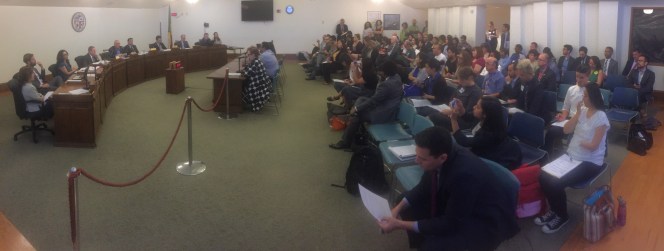As expected, today's Los Angeles City Council Transportation Committee meeting featured a showdown over how the city will spend its Measure M local return funding. Measure M is Metro's new half-cent sales tax. 16 percent of Measure M is returned to cities for local transportation projects and programs. The city of L.A. estimates that local return will amount to approximately $66 million annually.
Today's Transportation Committee meeting was considering a motion that would have primarily directed L.A. local return monies to resurfacing deteriorated roads. Instead, the committee sidestepped road repair and directed local return dollars to Vision Zero, including specific funding for bicycle facilities, and sidewalks.
Discussion began with the city's Chief Administrative Officer and Chief Legislative Analyst report [PDF] following the proposed council motion 16-0395 which would have dedicated two-thirds of Measure M local return funds toward road resurfacing, with the remaining funds going to "everything else."
Early on, Transportation Committee chair Mike Bonin made an alternative proposal, dedicating all of L.A.'s Measure M local return to "health, safety, and equity." Bonin characterized the committee's choice as "either fill a bunch of potholes or save a bunch of lives." Bonin's proposal would allocate funds as follows (after paying the city's 3 percent share on Metro Measure M projects in the city of L.A.):
- 60 percent for Vision Zero
- 20 percent for essentially Vision Zero curb-work "median island and curb extension improvements, including but not limited to bus bulbs, curb extensions, pedestrian refuge and median islands"
- 10 percent for sidewalk repair and reconstruction on Vision Zero High Injury Network corridors
- 10 percent for upgrade and expansion of bicycle infrastructure
Thirty-two public speakers, including City Councilmember Marqueece Harris-Dawson, urged committee members to support Vision Zero, safety, complete streets, walking, and bicycling, and to prioritize these improvements in underserved low income communities of color. Among the numerous groups commenting were Investing in Place, the L.A. County Bicycle Coalition, the American Heart Association, TRUST South L.A., AARP, Los Angeles Walks, California Walks, SCOPE, Prevention Institute and many others. No speakers testified in favor of resurfacing.
Councilmembers Nury Martinez and Jose Huizar spoke in clear support of Bonin's proposal.
LADOT General Manager Seleta Reynolds made the case for greater investments in saving lives, not only morally and ethically, but even in terms of the city's fiscal liability. Reynolds emphasized that fatalities are rising in Los Angeles, and that Vision Zero engineering improvements are data-driven proven remedies for preventing future deaths. Reynolds compared New York City's Vision Zero programs, funded at $155 million per year, to L.A.'s, currently under $4 million per year.
Councilmember Paul Koretz, apparently unaware of recent L.A. City Vision Zero studies, suggested that further study was needed before allocating funds to make streets safer. Koretz went on to blame pedestrian deaths on pedestrian behavior, and increased bicycle "accidents" on bicycle infrastructure. Koretz then questioned whether Measure M local return funding should go to Vision Zero or sidewalks.
Councilmembers David Ryu and Koretz proposed an alternative local return funding breakdown:
- 60% for road resurfacing
- 30% for Vision Zero
- 10% for bicycle infrastructure
The Ryu/Koretz proposal was not approved.
Bonin's proposal was approved on a 3-2 vote, with Ryu and Koretz opposed. This is a huge victory for health, safety, and livability in the city of Los Angeles. The Bonin proposal will still need to be approved by the full City Council.






